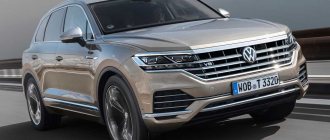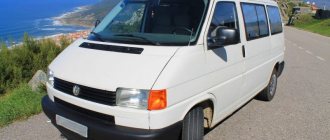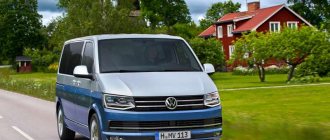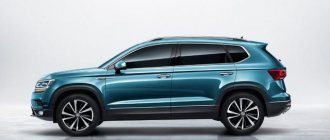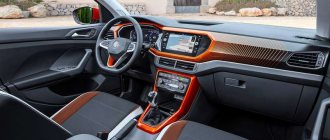Content
- What's inside the Caddy
- What drives the compact van?
- What problems will the owner face?
- How much does a used heel cost?
- With what problems is it sold?
- Conclusion
The third generation of Volkswagen Caddy appeared in 2004, and in 2010 it was restyled. The nimble Vagov “heel” immediately fell in love with car enthusiasts, who used the model not only for its intended purpose - for commercial transportation, but also as a family car. Today, about 270 used models before and after restyling are available to buyers. Let's look at what to look for before purchasing in this article.
Reviews from car enthusiasts
“I read reviews about the Volkswagen Caddy automatic and I want to object to the comfort of the interior. You didn't drive the 1974 models. I personally like the car for its heating and comfort. It's warm in winter, but not hot in summer. The car is maneuverable and economical.”
“I have no complaints or complaints about the model. The car is a fairy tale! I purchased a used car 2 years ago and have never looked under the hood. This despite the fact that the car is 2008. The previous owner took good care of the car. It drives great, either in the city or off-road.”
Volkswagen Caddy-automatic
“I didn’t like the car. The interior is noisy and the upholstery is cheap. The seats wore out quickly. I took the car for work. You have to travel a lot and transport cargo. Sometimes the whole family goes on vacation. And in winter it’s a total disaster. It takes a long time to warm up.”
What's inside the Caddy
The predecessor of the Caddy III was not as popular as its younger brother. He looked like a real working guy and was purchased exclusively for cargo transportation.
The third generation turned out to be more attractive. In addition to cargo versions, cargo-passenger options for five and seven seats were offered - Combi and Life. In 2008, VW released an extended version of the Maxi.
The cars are based on the Volkswagen Touran and Golf platform with leaf spring rear suspension. The solution is reliable, increasing the load capacity, but the ride is harsh for rear passengers, especially off-road.
Depending on the configuration, the Caddy is equipped with sliding side doors and a rear door, which can be a single lifting door or a double swing door. It is very convenient for loading various items, but the sliding door is bad for the paintwork. In places where the door roller moves, the paint peels off and “saffron milk caps” appear.
The inside is spacious and comfortable even for tall people. The interior is boring. Poor sound insulation, hard plastic and bare metal without cladding create the feeling that you are traveling in a shuttle bus. In winter it is as cold as public transport.
But there are plenty of shelves and space to stow and transport bulky cargo. Pleased with the many pockets, niches, glove compartments and cup holders. The main thing is not to forget what you put and where.
Options include an on-board computer, electric drive and heated mirrors, power steering, a multimedia complex with a rear view camera, Bluetooth, and an automatic parking system. The luggage compartment tends to lead the way: even in the 5-seater version it can accommodate 750 liters of cargo.
The Caddy's ground clearance is 146 mm. Not enough, but quite enough to avoid getting caught in the pits with your belly. In addition, there is a lower protection made of reinforced thermoplastic.
Also read: Volkswagen Polo 5 Review: Pros and Cons
DSG box "Volkswagen Caddy": pros and cons
Volkswagen provides an extended warranty on seven-speed transmissions. This option is convenient and practical to use. Reviews of the Volkswagen Caddy automatic with DSG gearbox are mixed. Like any other model, the Caddy has its adherents and critics.
Thanks to active gear shifting using two clutches, the car does not lose dynamics. In this way, it is possible to eliminate power failures when switching speeds. The concern's cars produced after 2008 are equipped with a “dry” clutch that does not require a large amount of oil.
The DSG system offers advantages over a conventional gearbox:
- up to 10% fuel savings;
- dynamic acceleration and no “rubber traction” effect;
- the ability to switch speeds manually;
- 20% less weight.
Along with obvious advantages, car enthusiasts highlight one drawback - high cost. A car with a DSG transmission costs 10% more than its counterparts with a manual transmission. In addition, the 6-speed gearbox has high oil consumption, and replacing it costs the owner a pretty penny.
Despite the fact that opinions about a box of this format are ambiguous, reviews of the Volkswagen Caddy DSG are mostly positive. Real drivers share their impressions of using the Caddy. Most often, the problem arises with wear and tear of parts in megacities. Frequent braking in traffic jams leads to abrasion of the edges.
What drives a compact van?
Volkswagen Caddy III is equipped with gasoline and diesel engines. The base unit is a 1.4-liter gasoline unit. His individual ignition coils fail. On early versions 1.4 (2004-2005), difficult cold starts are noted. Engine 1.6 with 102 hp. With. more reliable and practically does not cause problems for owners.
Of the diesel units, the best is 1.9 TDI with a power of 75 and 104 hp. With. It is cheap to operate, but expensive to repair. Replacing a broken nozzle with an original one costs 20 thousand rubles apiece. Diesel 2.0 is not reliable. Some people have a cracked cylinder head block.
In general, diesel engines “live well” on Russian diesel fuel, consume up to 6 liters in the city, but take a long time to warm up in winter. Some craftsmen solve the problem by insulating the engine compartment or installing an additional heating source in the cabin.
All versions of engines work with a 5-speed manual transmission. Late models have a 6-speed DSG robot. It is more expensive to maintain, and repairs cost a lot of money.
Also read: Volkswagen Phaeton: pros and cons of “cheap business”
Advantages and disadvantages of Volkswagen Caddy-automatic
The model attracts attention with its pleasant design and spacious interior, which can easily be transformed into a van. The multifunctional vehicle copes with the tasks of transporting a company of 7 people or 3 cubic meters of cargo.
The owners of the Caddy assure of its reliability. Some say that Volkswagen has never failed in 6 years. Others value low maintenance and easy repairs. The German auto industry is famous for the strength of its parts and resistance to wear.
Having looked at the reviews of the Volkswagen Caddy DSG, we can highlight the advantages:
- low fuel consumption;
- inexpensive repairs (and spare parts are always available);
- capacity;
- high-quality assembly;
- engine torque and dynamism;
- ease of operation and maneuverability;
- availability of electronic assistants;
- climate control and heated seats.
Thanks to a carrying capacity of up to 750 kilograms and a spacious interior, the car is used for commercial purposes.
Also, reading reviews about the Caddy automatic, one can come to the conclusion that the machine is justified in operation for family needs. Among the negative properties, owners note:
- long warm-up in winter;
- rapid wear of the robot clutch;
- wear of seats and interior trim during intensive use;
- corrosion of sills and arches.
It is worth noting that wear and tear of a car depend largely on the conditions of use of the model, mileage and age.
What problems will the owner face?
The savings in Caddy production are felt throughout. Cheap plastic in the cabin quickly becomes loose and begins to rattle. Tail light bulbs and fuses often burn out. The savings also affected the car windows. In winter, temperature changes often cause windshields and even headlights to crack. Windshield wiper shafts are susceptible to corrosion, which causes the wipers to work slowly.
There are also problems with the air conditioning. Stones often get into its radiator, causing damage. But the main “sore” of the Volkswagen Caddy is the thin layer of paintwork. Even small pebbles from gravel can easily destroy the coating. Rust quickly appears at the site of chips. The paint even wears off on door handles and buttons.
On TDI engines, the double-masked flywheel causes problems, breaking down when the mileage exceeds 100 thousand. Due to poor transmission oil, the manual transmission suffers.
Rear brake discs are damaged by rust or grooves machined by contamination. When buying a used Caddy, it is better to immediately buy new high-quality wheels. CV joint boots break and lose their tightness. Even lubricated, they can make strange sounds.
When buying a used Volks, we recommend paying attention to the rear side windows. Unscrupulous salespeople convert cargo versions into passenger versions, and then declare: “My wife only drove it to the store!” To identify deception, inspect areas near openings. On factory passenger versions there are recesses and places for inserting glass; on conversions they are not present.
Also read: Problems of the Volkswagen Passat B6 - is it worth buying a “German”
All owner reviews about Volkswagen Caddy III restyling
Good day. I got a new job, where they gave me a company car, a Volkswagen caddy. The first impression of the car was: wow, this is what Volkswagen means! That's what a German means! More precisely, it should be written: this is what German means! Written with a capital letter. It seemed like this to me then...
Now let's talk about everything in order. The first trip left a breathtaking feeling of comfort. The engine is almost inaudible, the voice can be heard only when accelerating, in smooth mode there is very good acoustic comfort. The pendant is amazing! No rolls, a dull quiet sound when driving over bumps, it perfectly works out the flaws of our roads, does not break through when I make mistakes, etc. The engine is turbocharged, the pickup is very pleasant, but you have to turn it. At first I didn’t understand why it was driving so sluggishly, it turns out I wasn’t turning it enough. On the highway at a speed of 60-80, it is better to stick the third one in order to overtake, since at 4 it will go very sluggishly, and at 3 it will shoot like a bullet. The box-engine tandem is perfect. No vibrations in the gearbox, no jerking when the clutch is suddenly released, everything is set up perfectly, the gears shift clearly, manual shifting is not at all annoying, you don’t even want an automatic with such a gearbox. Overall, it was a great pleasure to receive such a wonderful car.
During operation, I have already begun to study the habits of the car in more detail. The engine takes a very long time to warm up. Moreover, the temperature arrow does not move linearly. The car sits at XX for about 15 minutes every morning, the needle does not move. When starting from a stop, it jumps sharply to 3/4 of the operating temperature, but the air from the stove is cold. And in general, when the outside temperature is from +3 to +10, you need to drive about 7-8 km so that the needle reaches the operating temperature and hot airflow begins. Very uncomfortable. I don’t understand why this is so, and I’m scared to imagine what will happen in winter... Next is the jamb of the stove control unit. We turn off the warmed-up car, after 5 minutes we start it and cold air blows from the heater until the heater tap opening control is moved to the middle position and returned to maximum again. There is an electronic unit, that is, the tap itself is controlled by some kind of motor, apparently, since I only turn the resistor with the regulator, as far as I understand. Whether the firmware is buggy, so that you always have to adjust the maximum temperature again, or a glitch in the unit, I don’t know. This is very annoying and not pleasant. It’s still not possible to adjust the direction of the airflow blindly. The round wheel doesn’t give any resistance or feedback, there are no notches on it to understand where it’s blowing now and where you need to switch, so you have to take your mind off the road and look where the little red dot is and where it needs to be translate. I didn’t expect such a jamb from Volkswagen.
How much does a used heel cost?
The price for the third generation Caddy varies from a couple of hundred thousand to more than a million. The cheapest option costs 260 thousand:
And the most expensive copy in the restyled version of 2014 is sold for 1,350,000. The mileage is 126 thousand km, and the average annual mileage is almost 25,000 km. The car was clearly not in the garage.
Price of new and used Volkswagen Caddy
Cost of Volkswagen Caddy:
- Trendline equipment (1.6-liter unit, 5-speed manual transmission) - from 1.270 million rubles.
- Maxi Trendline package (1.6-liter unit, 5-speed manual transmission) - from 1.434 million rubles.
- Maxi Comfortline package (2-liter diesel engine, robotic gearbox) - from 2.204 million rubles.
For those who want to save money, a used Volkswagen Caddy is suitable, which, given its high quality, can be purchased at a great profit. Here the price tags for the 2010-2011 model are 650,000-760,000 rubles, for the 2013-2014 version - 900,000-1200,000 rubles.
With what problems is it sold?
Volkswagen Caddy is in demand on the secondary market. In the last two months alone, it has been checked 1,543 times. Selecting 20 random models from the avtocod.ru
, we found out that almost every second car was given away without technical and legal problems. Four cars were listed as leased and the same number had a duplicate title. Three out of 20 were sold with unpaid fines, two after an accident and one each with traffic police restrictions and changes to the vehicle design.
To buy a problem-free copy, we recommend that you carefully inspect the car and check its operating history. We found a 2008 diesel Caddy on a notice board. with mileage 205 thousand km:
We check the history through and see that the car has traffic police restrictions:
Restrictions may be associated with non-payment of taxes, fines, loans by the previous owner. The new owner will not be able to register the car until these restrictions are lifted.
Also read: Which Volkswagen Polo is better to choose?
Review of Volkswagen Caddy Maxi
Interior
The main difference between the Volkswagen Caddy Maxi is more space compared to a regular Caddy. The dimensions of the van are such that even those sitting in the third row do not have to worry about their comfort - they will have enough space to stretch their legs. Double and single seats can be transformed and, if desired, removed to increase trunk volume. There are very convenient niches under the chairs in which you can hide the necessary little things, such as a wrench.
The control panel here is no frills - the developers sought to make it so simple and understandable that the owner would not have to spend a long time understanding the sensors and instruments. And they succeeded.
Durable, hard plastic, laconic, dry, even somewhat boring design.
Exterior
Externally, the Caddy maxi also looks more advantageous - it has become more elegant and proportional compared to the short wheelbase. Otherwise, it retained all the features of a typical “people's car” - respectable, but without frills.
Read also Review of Volkswagen T4
Technical characteristics of Volkswagen Caddy
| Engine | 1.2-2.0 TSI; MPI; TDI 84-140 hp |
| Transmission | Mechanical/robotic |
| Maximum speed, km/h | 157-186 |
| Torque H*m max at rpm | 155 at 3800 – 4000 |
| Length, m | 4,5 |
| Width, m | 1,8 |
| Height, m | 2 |
| Wheelbase, mm | 2682 |
| Average fuel consumption, max, l | 6, 5 |
| Drive unit | Front/full (for 2.0 TDI, 110 hp) |
| Acceleration up to 100 km/h (sec) | 10 — 14 |
| Load capacity, t | 7,6-8 |
| Gross weight, t | 2, 3 — 2, 4 |
